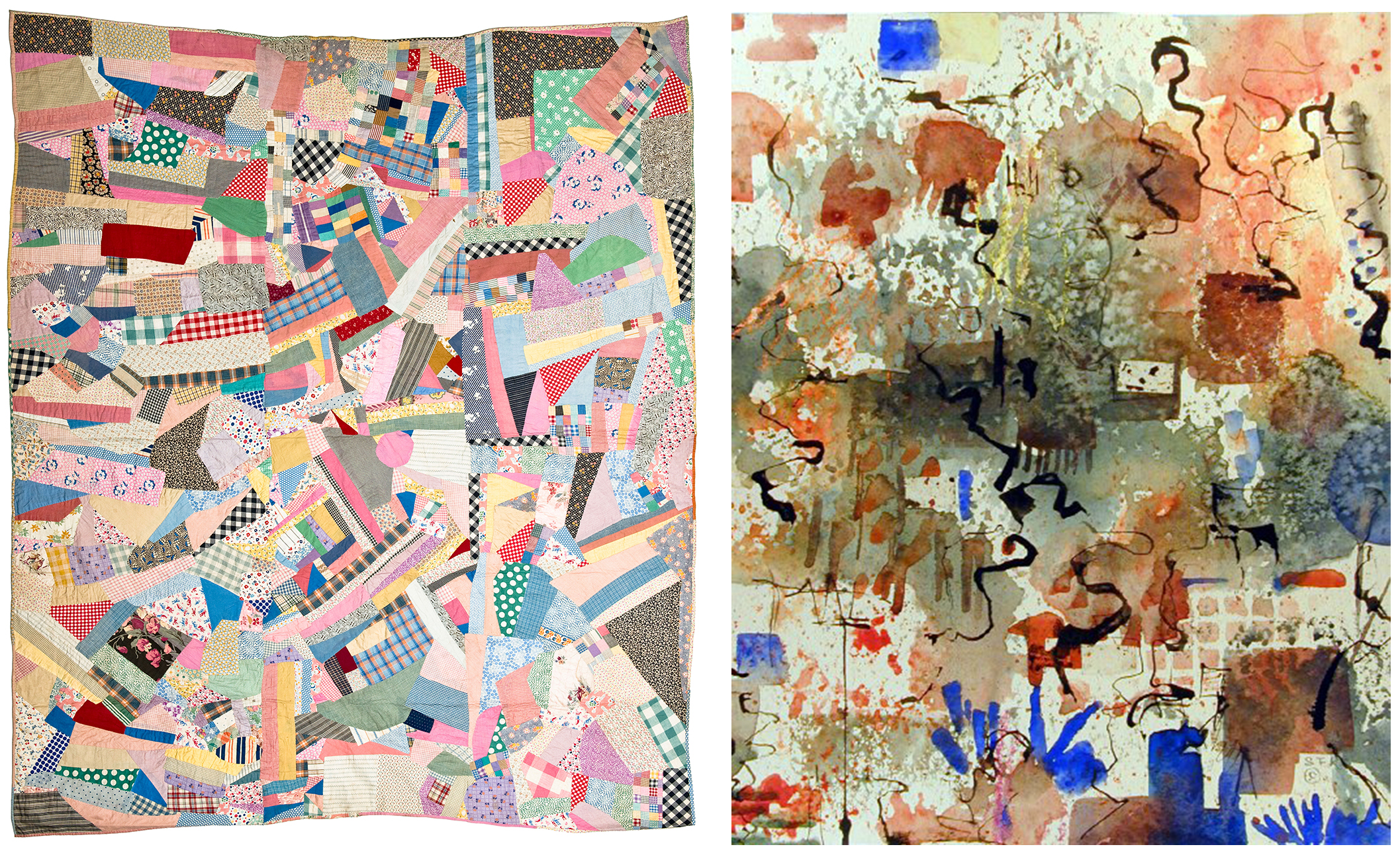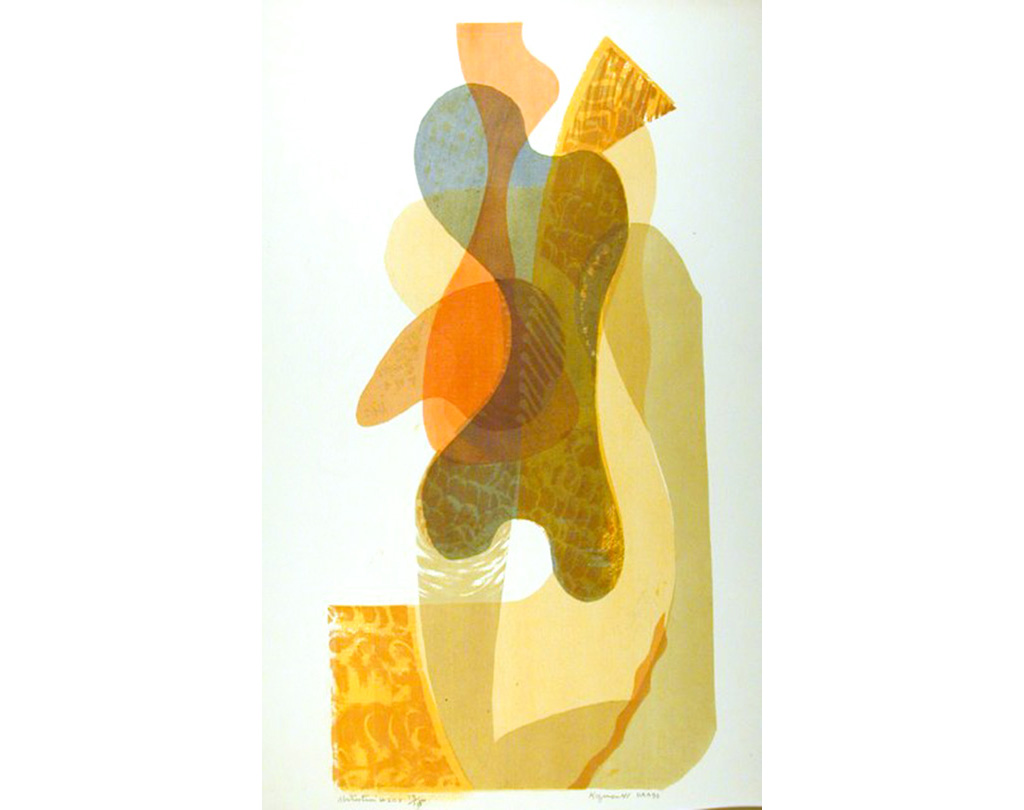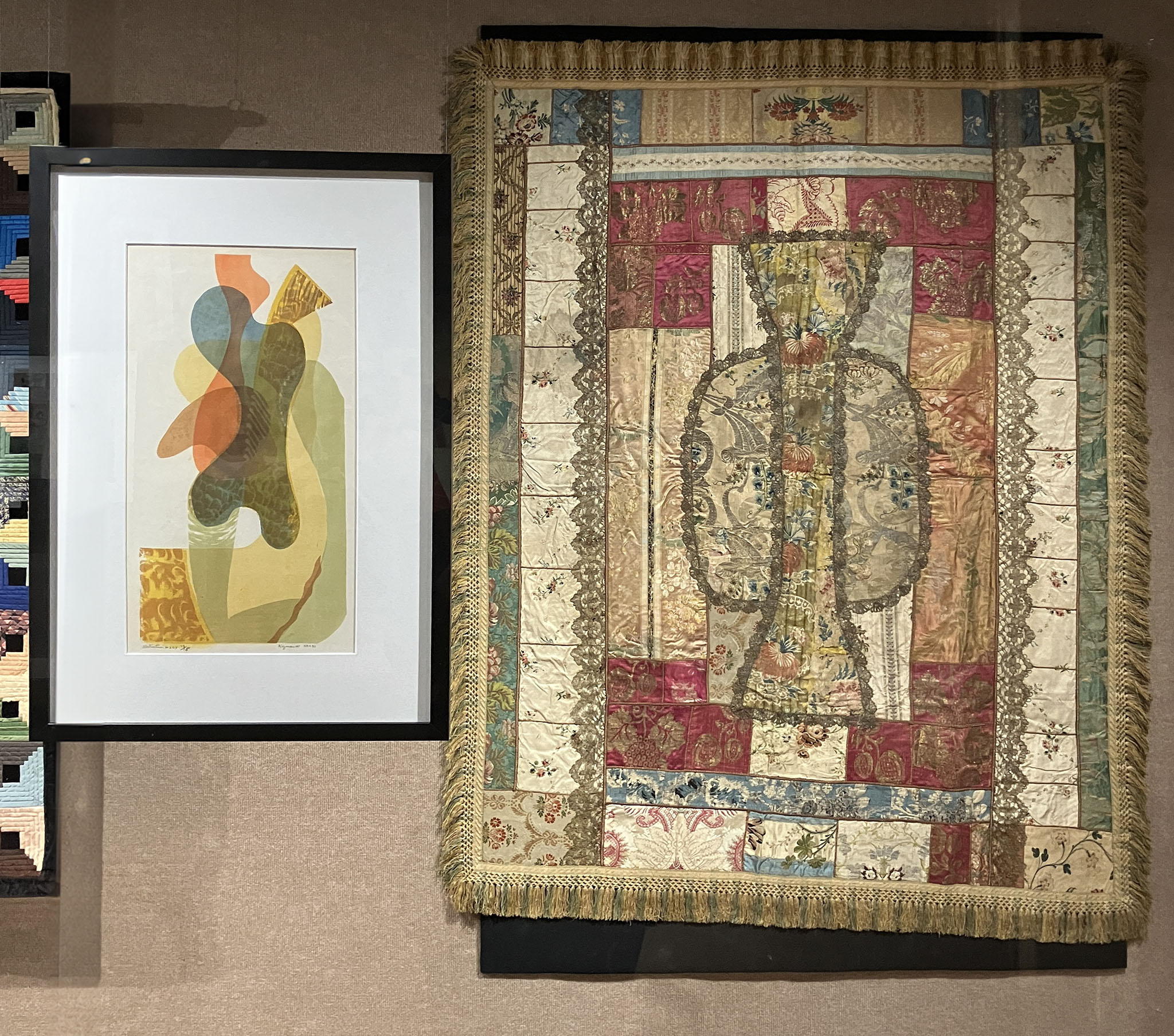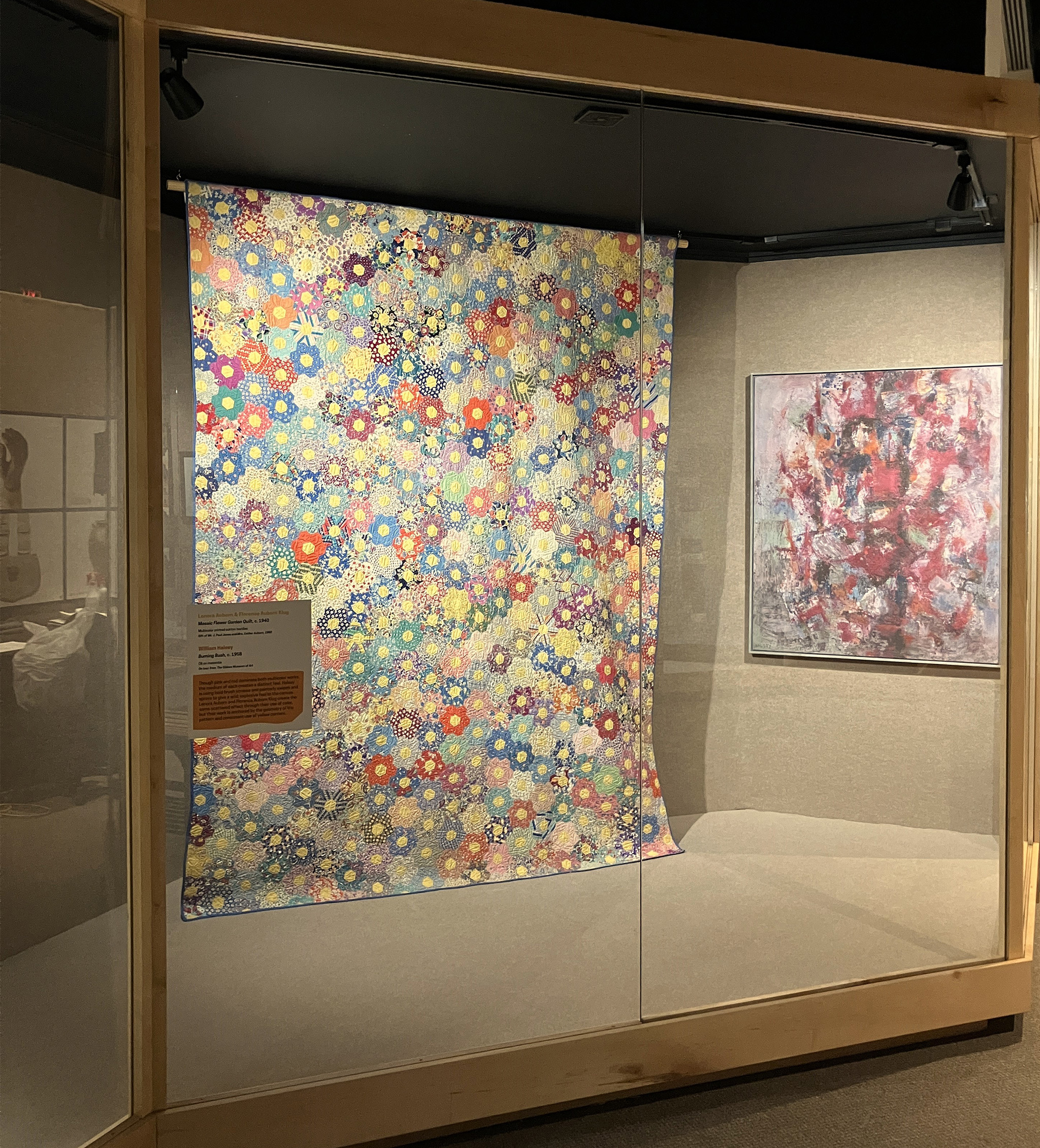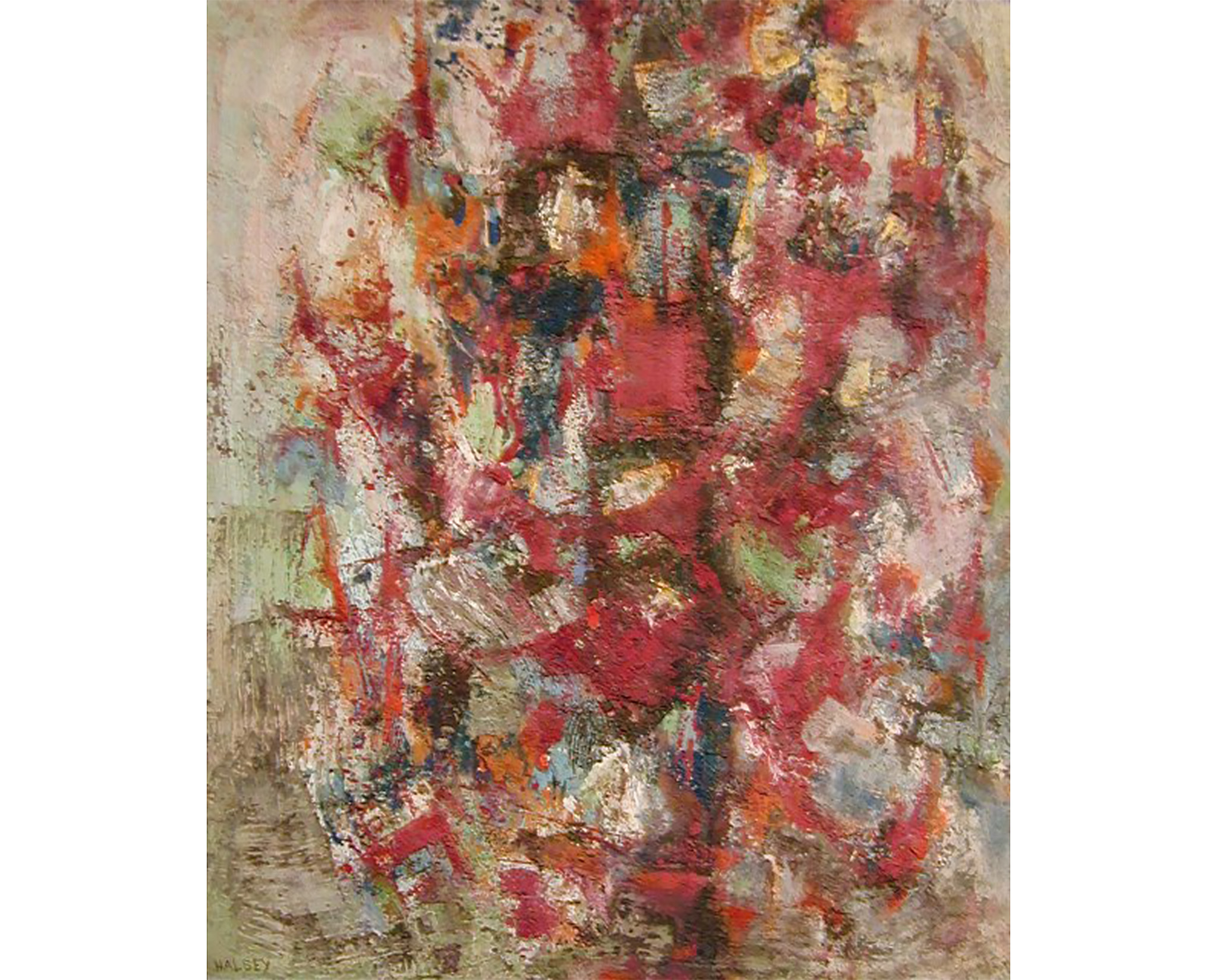The Perfect Pairing: Quilting and Abstract Painting
(left)
Multicolor cotton prints and solids scrap quilt, 1934, by Leila Ann Axson
Gift of Adra F. Benton, 2007
(right)
Untitled (Abstract), watercolor on paper, c. 1970s, by Sallie Frost Knerr
On loan from The Gibbes Museum of Art
“If modernism be a vital thing it must needs have roots in the past and be an essential expression of humanity: in short, it can only be a tradition.”
– Edwin Muir, “What is Modern” 1918
In 1971, The Whitney Museum of Art presented Abstract Design in American Quilts, showcasing the quilt collection of Jonathan Holstein and Gail van der Hoof. The display of the exhibit, with quilts in abstract designs hung on the walls formatted as any paintings exhibition might be presented, changed the art world. The 20th century modern art movements had changed the perception of textile art, and quilts were no longer viewed as simply bed coverings designed for warmth, but as art in their own right. Now they had the golden seal of approval from one of the leading contemporary art museums in the country.
Fifty years on from that exhibition, much has changed in the quilting community. Quilters share their latest projects on social media, and interact within online communities. Sewing machines have internal computer systems, and long arm quilting machines have revolutionized large scale projects. Artists like Bisa Butler reinvent the concept of quilting as a fiber art, creating complex portraiture through color and pattern.
Abstraction #208, screenprint on paper, 1941, by Myron Kozman
On loan from The Gibbes Museum of Art
Pieced Table Cover, 18th century floral silks and gold lace, late 19th – early 20th century, by an Unknown Artist
Gift from the Estate of Gertrude Legendre, 2012
Yet as much as things change, they stay the same. Quilting is still a social art, often practiced within community. It is bound by the nature of its medium, textiles, and the work requires hand cutting and pressing that machines have yet to replicate. Just as painters are trained on the history of their calling, quilters can visit specialized museums, like the International Quilt Museum in Lincoln, Nebraska, to research and study the work of artists who came before them.
From that history is a rich tradition of inspiration, from the selection of materials to the replications of well known patterns. In The Art of Abstraction: Modernism in Quilting, we have asked our visitors to consider that inspiration on a deeper level. Though many artists of the modernist and abstract art movements in the mid-20th century would likely name a diverse variety of inspirations for their work, how many of them would consider quilts? The same fragmentary arrangements of color, surprising clashes of pattern, and construction of unusual shapes can be found in late-19th century quilting as in mid-20th century painting. Would those painters and avant-garde artists think of their grandmother’s quilts in their visual vocabulary, and credit these relatives with seeding their early creative landscape?
Mosaic Flower Garden Quilt, multicolor printed cotton textiles, c. 1940, Lenora Auborn and Florence Auborn Klug
Gift of Mr. J. Paul Jones and Mrs. Esther Auborn, 1980
Burning Bush, oil on masonite, c. 1958, by William Halsey
On loan from The Gibbes Museum of Art
By placing these works in juxtaposition with one another, we get a richer interpretation of both. The ingenuity, eye for color, shaping of details, and spark of humanity reach the viewer, and allow for consideration of both mediums in a new light. Quilting was long dismissed as a hobby or a craft for women, and painting was elevated as both a highly rarefied profession and an experimental art form. Now we are called to wonder – who was really cutting edge? Was it the modernist painters? Or their elders, who were designing works of art 50, 75, or even 100 years before?
Regardless, the viewers of these works are the lucky ones, getting to see the brilliance and vibrancy to both the quilts and the paintings, and how they enhance one another in the gallery. Here at The Charleston Museum we are so grateful that the Gibbes Museum of Art was willing to open their collection to us, so we could have a chance to let these works shine together.
The Art of Abstraction: Modernism in Quilting is open now through September 15, 2024 in the Historic Textiles Gallery. We hope you will visit soon!
-Virginia Theerman, Curator of Historic Textiles March 2024
Select Bibliography
Hanson, M. F., and J. Gregory. Abstract Design in American Quilts at 50, 1971-2021. International Quilt Museum, University of Nebraska-Lincoln, 2021. https://books.google.com/books?id=Ky38zQEACAAJ.
Muir, Edwin. “What Is Modern?” In Modernism: An Anthology of Sources and Documents, by V. Kolocotroni, J. Goldman, and O. Taxidou, 354–57. Edinburgh University Press, 1918. https://books.google.com/books?id=p52ctAEACAAJ.
Peterson, Karin Elizabeth. “Discourse and Display: The Modern Eye, Entrepreneurship, and the Cultural Transformation of the Patchwork Quilt.” Sociological Perspectives 46, no. 4 (2003): 461–90. https://doi.org/10.1525/sop.2003.46.4.461.


